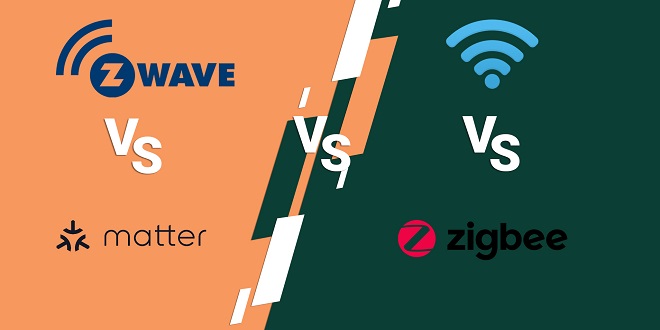Z-Wave Vs Zigbee vs WiFi – Which one is best?

Comparing Z-Wave and Zigbee with WiFi is a bit like comparing apples, oranges, and bananas. They are all fantastic, designed with their unique benefits, but fundamentally, different.
It is important to understand the differences between these three popular technologies, as they are not compatible. You can only set up your smart home automation system to Z-Wave or Zigbee WiFi with a limited number of compatible devices.
Z-Wave
Z-Wave protocols have been in use for nearly 20 years. They continue to be hugely popular. It is able to see through walls and floors with a good deal of ease, thanks to its long lines of sight.
The system can be used to build a strong mesh network in a space of unlimited size, as mains-powered Z-Wave products can also act as signal repeaters.
These are just a few examples of popular products and devices that can connect to a Zwave network:
Light switches
Bulbs
Plug-in switches
Thermostats
Sensors
Remote Controls
Door Locks
Garage Door Controllers
Water Valves
The Z-Wave system’s compatibility with many devices is one of its greatest strengths. It can also be used with many smart home software suites. However, it is not compatible with Amazon and Google smart speakers.
Z-Wave is a popular choice for both small and large businesses due to its ability to create a vast mesh network without sacrificing performance. Z-Wave, however, is more popular for household use than Zigbee and Wi-Fi.
Z-Wave products broadcast at different frequencies in different parts. Therefore, some Z-Wave products may not work with Z-Wave systems in Europe if they are purchased in the USA.
Read Also: Masstamilan
Zigbee
Zigbee technology was also introduced around 20 years ago. It has gained popularity in households all over the world over the last few years. Zigbee devices can also be used as repeaters like Z-Wave to solve problems related to floors and walls.
Z-Wave’s range isn’t as wide as Zigbee’s, but it is much more affordable. Evvr’s Zigbee3.0 In-Wall Relay Switch is quick and simple to install. This allows for easy swapping with any other light switch without neutral wire. The Zigbee is one of the easiest smart devices to integrate into any home.
These are some of the most popular products and devices that can be added into a Zigbee mesh system:
Bulbs
Sensors
Plug-in switches
Remote Controls
Door Locks
Zigbee’s simplicity and affordability make it the best smart home automation technology. Zigbee devices can be used with many popular multi-tech hubs such as SmartThings and Wink. They also work with Amazon’s Echo Plus.
The best part is that the Zigbee system operates on the same 2.4GHz band globally, so there are no compatibility issues due to product purchase location. Their competitive prices reflect the fact that they are easier to manufacture and transport.
Wi-Fi
Many smart devices can be connected to the Wi-Fi network of their homes. This is not a way to create a mesh network. Instead, each smart device will connect directly with the central Wi-Fi router of the home with a signal booster.
A system such as this has one major drawback: it requires that all devices be placed within the router’s direct reach in order for them to work. This can lead to problems in areas with weak Wi-Fi signals. Wi-Fi can be quite power-hungry so smart devices powered by Wi-Fi have a shorter life span.
These popular controllers and devices can be integrated into a Wi-Fi network:
Light switches
Bulbs
Thermostats
Plug-in switches
AV Controllers
Irrigation controllers
Sensors
Door Locks
Garage Door Controllers
A smart home automation system that uses Wi-Fi is easy to set up and inexpensive. However, it relies on strong and consistent signals from the router. The whole system could be affected by a Wi-Fi signal problem or outage.
It can be a cost-effective way to automate your home. The next step is to upgrade to a mesh network, the Zigbee for domestic use.
Feel Free to Read More: Isaimini
Making an informed decision is crucial when considering Vidmate old version. Benefits include familiarity and stability. Drawbacks may involve security risks and lack of updates. Evaluate your needs carefully before choosing. Ensure compatibility with your device and consider potential risks. Ultimately, the decision rests on your priorities. Balance the advantages and disadvantages to make the best choice.





